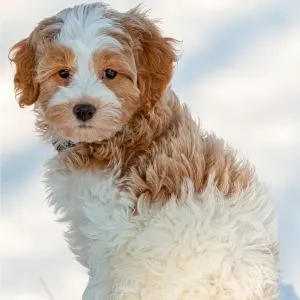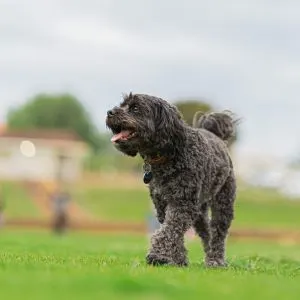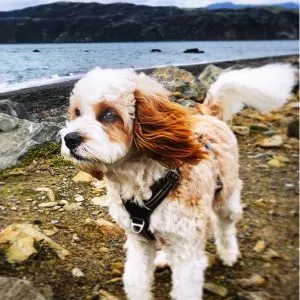You may have seen their adorable faces in the park. Or maybe you’ve seen them on a celebrity’s social media post and thought you just had to add one to the pack. Regardless of where you fell for them, the Cavapoo (aka Cavoodle or Cavadoodle) has been stealing hearts for a (CKCS) and a Poodle, are celebrated for their adorable appearance, affectionate personalities, and the ability to fit in with a wide range of preferences and lifestyles. This last trait is thanks to the various Cavapoo Generations that allow you to find the perfect pup to fit your needs.
These generations, often referred to as F1, F1b, F1bb, F2, F3 and beyond, play a pivotal role in shaping their characteristics. These classifications give guidance to the unique blend of traits inherited from their Cavalier King Charles Spaniel and Poodle lineage, influencing factors such as size, coat type, and temperament.
Whether you desire a compact companion for apartment living or a larger, more active partner for outdoor adventures, there’s likely a Cavoodle generation that aligns perfectly with your needs.
Join us as we explore the world of Cavoodle generations in greater detail, uncovering the distinctive qualities that make each classification special, and providing you with the insights you need to make an informed decision on which Cavoodle generation is right for you.

Why Were Cavapoo Generation Classifications Created?
Cavoodle generation classifications were introduced to help breeders and prospective dog owners understand the genetic makeup and characteristics of individual mixed breed dogs. The primary reasons for creating these classifications are:
- Predictability: By categorizing them into different generations based on breeding, breeders and buyers can have a reasonable expectation of a dog’s appearance, temperament, and health characteristics. This allows for a more informed decision-making process when selecting a puppy.
- Allergen Friendliness: Some individuals have allergies or sensitivities to dog dander. Understanding the generation of a crossbreed can help people choose a dog with a coat that is closely related to the poodle’s coat and is less likely to trigger allergies.
- Consistency: The goal of breeding is to produce dogs with consistent traits and qualities. Generational classifications help breeders work towards this goal by providing a clear framework for selective breeding.
Cavapoo Generations Classifications are not always consistent
While the generation classifications provide a framework for understanding certain characteristics, they are not always entirely predictable due to several factors:
- Genetic Variability: Even within the same generation, individual puppies can inherit different combinations of genes from their parents. This genetic variability can result in variations in coat type, color, size, temperament, and health all within a single litter.
- Environmental Factors: Environmental factors, including diet, exercise, and socialization, can play a significant role in a Cavoodle’s development.
- Selective Breeding Goals: Some breeders prioritize specific traits over others in their breeding programs. This can lead to variations in the traits and characteristics of the Cavoodle from one breeder to another, even within the same generation.

Decoding the Cavapoo Generations
What does “F” stand for?
The “F” in the terms “F1” and “F1b” etc. stands for “Filial”. It is a genetic term used to describe the generation or degree of hybridization in a breeding program.
In the context of Cavoodles and other hybrid dog breeds, “F1” and “F1b” refer to different generations of dogs resulting from specific crosses. Here are a couple of examples:
- F1 (First Generation): An F1 Doodle is the product of breeding a purebred non-poodle with a purebred Poodle. The resulting puppies are considered the “first filial generation” because they are the first generation of offspring from two distinct purebred parent breeds. In this situation the doodle will have a 50% genetic makeup from each parent breed.
- F1b (First Generation Backcross): An F1b Doodle, on the other hand, is the result of crossing an F1 Doodle (first generation) with a Poodle. The “b” in F1b stands for “backcross.” This generation introduces more Poodle genetics into the mix, typically resulting in a dog with a higher percentage of Poodle genes.
Looking for a Cavapoo? Consider getting a Cavapoo Rescue or take a look at our Cavapoo Names post for naming ideas.
Cavapoo Generation Chart – Info-graphic

F1, F1b, F1bb, F2, F2b, F2bb, F3 and Multi-generation Explained
Now, let’s break down the various Cavoodle generations and how each one affects the Cavapoo’s Coat, price, temperament, shedding, health and size.
F1 Cavapoo (First Generation)
The F1 Cavoodle represents the initial cross-breeding between a purebred Cavalier King Charles Spaniel and a purebred Poodle. These puppies inherit an equal genetic mix of both breeds, resulting in a 50% Cavalier and 50% Poodle lineage. Now let’s see how this generation affects their traits.
- Coat: F1 Cavoodle typically boast a wavy or slightly curly coat, with individual variations.
- Price: F1 Cavadoodle are often more affordable than later generations due to the relatively straightforward breeding process.
- Temperament: These pups usually inherit the friendly, affectionate, and easygoing nature of both parent breeds, making them excellent family pets.
- Shedding: F1 Cavapoos can exhibit low to moderate shedding.
- Health: Generally, F1 Cavoodle enjoy good health, provided that both parent breeds were healthy and properly screened.
- Size: F1 Cavoodles can vary in size depending on the size poodle that is used for breeding. Their average weight range is 12 to 25 pounds and height is 9 to 14 inches at the shoulder.

F1b Cavapoo (First Generation Backcross)
The F1b Cavapoo is the result of crossing an F1 Cavapoo with one of the parent breeds. Most often this crossback is done using a Poodle. This cross typically has a higher percentage of Poodle genetics, usually around 75% Poodle and 25% CKCS. This increase in Poodle genetics often results in a curlier, more hypoallergenic coat.
- Coat: F1b Cavoodles typically exhibit curlier, low-shedding coats, which make them more suitable for individuals with allergies. But remember you can still be allergic to the low shedding dogs.
- Price: Due to their low-shed properties and desirable coat characteristics, F1b Cavoodles are often more expensive than F1s.
- Temperament: The friendly and affectionate nature of F1 Cavoodles is preserved in the F1b generation, though they may lean a bit more towards the poodle’s high energy personality.
- Shedding: F1b Cavoodles are known for minimal to no shedding, a result of their increased Poodle ancestry.
- Health: While generally healthy, it’s crucial to ensure the well-being of the purebred Poodle and Cavalier parent to maintain overall health.
- Size: F1b Cavapoos’ size remains consistent with that of F1s.
F1bb Cavapoo (Second-generation Backcross)
The F1bb Cavapoo is the result of breeding an F1b Cavapoo with a purebred Poodle. This generation prioritizes coat quality and maximizes hypoallergenic properties. This breed is believed to be approximately 87.5% Poodle and 12.5% Cavalier. Due to the increase in poodle genetics, the F1bb Cavoodle will be closely related to the poodle.
- Coat: F1bb Cavapoos boast extremely curly coats, which is less likely to shed than an F1 Cavapoo. This makes them a good choice for someone who prefers low-shedding dogs.
- Price: Due to their highly sought-after coat characteristics, F1bb Cavapoos are typically on the higher end of the price spectrum. The higher price reflects the breeding process and the effort involved in producing a dog with specific coat characteristics. Finding an F1bb will be difficult.
- Temperament: The F1bb Cavoodle leans towards the poodle’s personality, losing most of the Cavalier’s personality
- Shedding: F1bb Cavapoos are known for minimal to no shedding, thanks to their strong Poodle lineage.
- Health: F1bb Cavapoo will be more susceptible to inherited health issues of the poodle due to the increase in Poodle genetics. It is best to use a breeder that tests for these health conditions.
- Size: The size range of F1bb Cavapoos is similar to that of other F1 and F2 generations.

F2 Cavapoo (Second Generation)
The F2 Cavapoo is the result of breeding two F1 Cavapoos. This generation has the most variations when it comes to coat type, temperament, shedding, health and size. Although breeders like to say that this generation retains a 50% CKCS and 50% Poodle genetic makeup, the reality is that no one knows which genes are being passed down to the offspring. This results in a greater variability within the F2 generation.
- Coat: F2 Cavoodles can display a variety of coat types, ranging from a long silky coat to a wavy or curly coat. The shedding level varies among individual F2 Cavapoos, making it moderate on average.
- Price: F2 Cavadoodles are often more expensive than F1b and F1bb generations due to their advanced breeding.
- Temperament: These pups inherit a blend of traits from their F1 parents, typically including the friendly and loving disposition characteristic of the Cavalier and the intelligence of the poodle.
- Shedding: While shedding varies among individual F2 Cavapoos, it’s generally moderate, influenced by their diverse genetic makeup.
- Health: F2 Cavapoo may inherit some genetic health issues from either the poodle or Cavalier, but generally enjoy hybrid vigor.
- Size: The size range of F2 Cavapoos aligns with that of F1 Cavapoos.
F2b Cavapoo (Second Generation Backcross)
The F2b Cavapoo is the result of crossing an F2 Cavapoo with a Poodle. You can also crossback to the Cavalier King Charles Spaniel, but this is less common.
Just like with the F1b, this generation has a higher percentage of Poodle genetics, usually around 62.5% Poodle and 37.5% CKCS. However, once you get past the first generation, it may be hard to tell which genes are passed down without genetic testing.
- Coat: F2b Cavapoos typically exhibit curlier, low-shedding coats.
- Price: While generally more affordable than F1b and F1bb generations, F2b Cavapoos may still command a higher price compared to F2s due to their desirable coat characteristics.
- Temperament: The friendly and affectionate temperament of the Cavapoo is combined with the intelligence and trainability of the poodle.
- Shedding: F2b Cavoodles are known for minimal to no shedding, a trait inherited from their Poodle lineage.
- Health: F2b Cavoodles tend to be healthier due to their higher Poodle genetics, but are susceptible to the health conditions that can affect the Poodle.
- Size: F2b Cavapoos’ size aligns with that of other F1 and F2 generations.

F2bb Cavapoo (Third Generation Backcross)
The F2bb Cavapoo represents a further refinement of backcrossing, achieved by breeding an F2b Cavapoo with another purebred Poodle. This generation continues to prioritize coat quality and maximize hypoallergenic properties.
- Coat: F2bb Cavapoos feature extremely curly, non-shedding coats.
- Price: Due to their advanced generation and the increased Poodle genetics, F2bb Cavapoos are often more expensive than both F1bb and F1 generations. This higher cost reflects the selective breeding process and the focus on producing dogs with specific coat characteristics.
- Temperament: Like their F1bb counterparts, F2bb Cavoodles tend to lean towards the Poodle’s temperaments due to their substantial Poodle heritage. They are known for their intelligence, trainability, and friendly nature, but you will lose much of the Cavalier’s personality.
- Shedding: F2bb Cavapoo have minimal shedding, similar to F1bb Cavoodle. This characteristic is especially appealing for those seeking a clean home environment.
- Health: The F2bb can inherit health issues from their parent breeds. However, due to the increased Poodle genetics they have an increased risk of health issues related to the Poodle. Therefore it is essential that the breeder perform genetic health testing on breeding dogs.
- Size: F2bb Cavapoos’ size aligns with that of other F1, F2 and F2b generations
F3 Cavapoo (Third Generation)
The F3 Cavapoo is the result of breeding two F2 Cavapoo. This generation, like the F2s, is believed to retain a 50% CKCS and 50% Poodle genetic makeup. However, there is probably more variation in their genetic make-up than a 50/50 split. This results in greater variability in coat type and temperament within the F3 generation. It is rare to find a F3 Cavapoo puppy for sale these days.
- Coat: Coat types in F3 Cavapoo can range from wavy to curly, with moderate shedding.
- Price: F3 Cavoodles may command a higher price compared to F2s.
- Temperament: Their temperament can vary, but they generally exhibit a blend of traits from both parent breeds.
- Shedding: While shedding varies among individual F3 Cavapoos, it generally falls within the low to moderate range, influenced by their diverse genetic makeup.
- Health: As with all generations, the overall health of F3 Cavoodles depends on the health of their parent breeds.
- Size: F3 Cavapoos’ size range aligns with that of F1 and F2 Cavapoos.

Multi-generations Cavapoo
Multi-generation Cavapoos are the result of breeding Cavapoos from various generations, including F1, F1b, F2, F2b, F3, and so on. These dogs have a more diverse genetic background. Breeders of later Cavoodle generations focus more on specific traits they want to see in the dogs rather than the generation.
- Coat: Carefully bred multi-generation Cavapoos will have less variation in their coat types, with many breeders striving for a wavy, or slightly curly coat. However if the breeder is not careful with their breeding practices they can end up with a wide range of coat types.
- Price: The price of multi-generation Cavapoo can vary depending on their specific genetic makeup and traits. However they tend to cost more than the other generations.
- Temperament: They typically exhibit a consistent and friendly disposition that the Cavapoo is known for.
- Shedding: Multi-generation Cavoodles are known for minimal to no shedding, thanks to their extensive Poodle ancestry and careful breeding.
- Health: Multi-generation Cavoodles may inherit some genetic health issues from their lineage but often enjoy hybrid vigor due to their diverse genetics.
- Size: Multi-generation Cavoodles’ size range is usually more consistent and predictable compared to earlier generations.
Understanding the various Cavoodle generations, from F1 to multi-generation, is helpful for making an informed decision when choosing your next canine companion.
The breeding process for each generation is designed to emphasize specific traits, and these generations are created with the intention of meeting the diverse needs and preferences of prospective Cavapoo owners.
However, while each generation comes with its unique set of characteristics, including coat type, shedding, temperament, and health, there are no guarantees that an individual dog will conform to the norms. Much of it depends on the breeder you choose.
